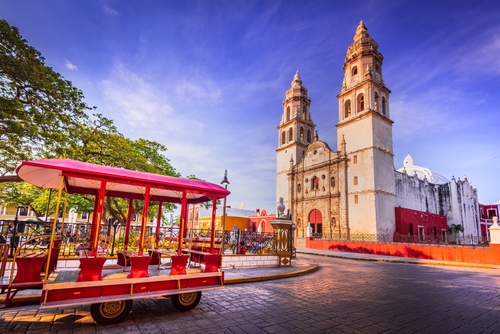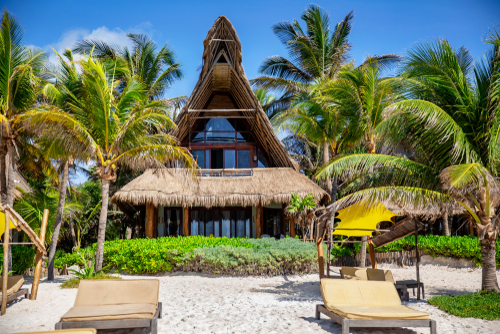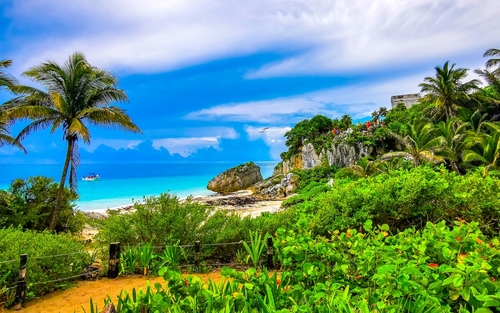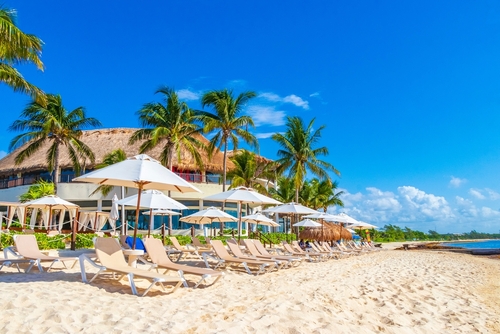Rental Income in Mexico: A Guide for Property Investors

A vibrant culture, buzzing colonial cities, and miles of stunning coastline draw millions of visitors to Mexico each year. ©Shutterstoick.com/ecstk22
Why Mexico is a Hotspot for Rental Properties
Mexico’s booming tourism industry, affordable real estate, and vibrant culture make it an attractive destination for property investors. With over 40 million tourists visiting annually, there’s a steady demand for short-term rentals in popular areas like the Riviera Maya, Puerto Vallarta, Tulum, and San Miguel de Allende. Additionally, long-term rentals are gaining traction among expats and digital nomads, ensuring year-round income potential.
Investors are drawn to Mexico not only for its natural beauty and cultural allure but also for its lucrative rental market. Properties in high-demand areas can generate substantial rental income, especially when optimized for the right target audience.

Reviewed by Ronan McMahon
Ronan McMahon is an Amazon best-selling author and expert in international real estate. He regularly contributes to Overseas Dream Home. Visit his website at ronanmcmahon.com
Short-Term Rental Opportunities
Targeting Tourists
Short-term rentals in Mexico’s most popular tourist destinations can be exceptionally profitable for property owners. Cities and regions like Cancun, Playa del Carmen, Tulum, Puerto Vallarta, and Cabo San Lucas are magnets for travelers seeking idyllic beaches, lively nightlife, and rich cultural experiences. Properties located close to beaches, cultural landmarks, or bustling city centers consistently command premium nightly rates due to their prime locations and accessibility.
To maximize income potential, it’s important to present your property as a desirable option for tourists. Investing in modern amenities such as high-speed Wi-Fi, air conditioning, and fully equipped kitchens can significantly enhance its appeal. Having features like rooftop terraces, private pools, or panoramic ocean views will also make the property stand out. Guests are drawn to experiences as much as accommodations, so properties that offer added value, such as proximity to popular attractions or a tranquil environment, are likely to generate higher returns.
Presentation is key in attracting bookings. High-quality photography showcasing the property’s best features, along with detailed descriptions emphasizing location, amenities, and nearby attractions, can make a listing far more appealing. Platforms such as Airbnb and Booking.com prioritize listings with professional photos and positive reviews, so investing in creating a visually compelling profile is crucial. Additionally, thoughtful touches such as local guides or welcome packages for guests can elevate the experience and lead to glowing reviews, which will further boost visibility and credibility.
Effective marketing also plays a vital role in ensuring consistent bookings. Listing the property across multiple platforms broadens exposure to potential guests, while leveraging social media can increase interest by showcasing the property’s unique appeal through engaging content. Collaborations with local businesses, such as tour operators or travel agencies, can also drive interest and help your property stand out in a competitive market.
Seasonal Demand
Tourist destinations in Mexico often experience fluctuations in demand throughout the year, driven by holidays, festivals, and seasonal preferences. Winter months, particularly from December to March, tend to attract visitors escaping colder climates, making it the high season for destinations like Cancun, Puerto Vallarta, and Cabo San Lucas. Similarly, holidays like Christmas, New Year’s, and Easter bring a surge of travelers looking to relax or celebrate with loved ones.
Pricing strategies should be adjusted to reflect seasonal demand. During high season, nightly rates can be increased to reflect the influx of travelers willing to pay more for accommodations. Offering special packages, such as festive-themed stays or early-booking discounts, can further maximize revenue during these peak periods.
In contrast, the off-season presents an opportunity to attract a different demographic. Reduced rates and promotional offers can entice budget-conscious travelers or those looking for quieter vacations. Highlighting the benefits of visiting during these periods, such as fewer crowds and more intimate experiences, can be effective in maintaining steady bookings. Additionally, niche markets like digital nomads or retirees may prefer to travel during off-peak months, providing a reliable source of occupancy when traditional tourism slows down.
By understanding the nuances of seasonal demand and implementing thoughtful pricing and marketing strategies, property owners can optimize their rental income year-round. This balance ensures consistent occupancy while maximizing revenue during peak travel times.
Long-Term Rental Opportunities
Mexico’s evolving expat community and the increasing number of remote workers have created a thriving market for long-term rental opportunities. Cities such as Mexico City, Mérida, and San Miguel de Allende are especially attractive to individuals and families seeking an affordable yet high-quality lifestyle. These locations offer a blend of cultural richness, modern amenities, and a more relaxed pace of life, making them ideal for long-term tenants.
Expats and digital nomads often look for properties that cater to their specific needs. High-speed Wi-Fi is essential for remote workers, while dedicated office spaces and ergonomic furniture significantly enhance a property’s appeal. Furnished rentals with modern kitchens, comfortable living areas, and proximity to grocery stores, cafes, and co-working spaces are also in high demand. Including amenities such as gated access, secure parking, or pet-friendly policies can further increase interest from prospective tenants, as these features align with the lifestyle priorities of many long-term renters.
Unlike short-term rentals, long-term leases offer property owners financial stability and reduced turnover. With consistent monthly payments, long-term rentals provide predictable income that isn’t impacted by seasonal tourism fluctuations. Additionally, these arrangements often involve tenants covering utilities, minor repairs, and routine upkeep, which lowers the ongoing maintenance burden for property owners. This can be particularly advantageous for landlords who reside outside of Mexico or prefer a more hands-off approach to property management.
However, ensuring success with long-term rentals requires careful planning and due diligence. Tenant screening is a crucial step to ensure reliability and on-time payments. Background checks, references, and proof of steady income can help minimize potential risks. For international tenants, understanding and accommodating visa-related requirements or lease agreements in their native language can streamline the process and foster trust.
Marketing a long-term rental effectively is key to attracting the right audience. Property owners should highlight features that appeal to expats and remote workers, such as proximity to vibrant cultural districts, walkable neighborhoods, or reliable transportation options. Creating detailed and visually appealing listings on platforms like Zillow Mexico, Facebook Marketplace, or expat forums can help reach potential tenants.
By targeting the growing demand for long-term rentals among expats and digital nomads, property owners in Mexico can secure a stable and lucrative income stream while contributing to the thriving rental ecosystem in some of the country’s most desirable cities.

The city of Merida, in Mexico’s Yucatan, is a favorite with long-term renters like retirees and digital nomads. ©Shutterstock.com/ecstk22
Legal Considerations for Rental Properties in Mexico
When renting out property in Mexico, understanding the legal framework is essential for a smooth and compliant experience. The country’s regulations encompass tax obligations, licensing requirements, property ownership laws, and tenant rights, making it critical for property owners to navigate these areas carefully.
Tax Obligations
Rental income earned from properties in Mexico is taxable, and the rate of tax depends on the residency status of the owner. Non-residents are taxed at a flat rate of 25% on gross rental income, while residents can opt for the standard income tax system, which allows deductions for expenses, such as maintenance, utilities, and property management fees. To ensure compliance, property owners must register with Mexico’s tax authority, the Servicio de Administración Tributaria (SAT). Registration requires obtaining a tax identification number and issuing electronic invoices (facturas) to tenants or rental platforms for income reporting. Consulting a local tax advisor is highly recommended to navigate these requirements, optimize tax liabilities, and avoid penalties for non-compliance.
Licensing Requirements
In popular tourist destinations such as Cancun, Playa del Carmen, and Mexico City, local authorities often require special permits or licenses for short-term rentals. These regulations aim to regulate the growing vacation rental market and ensure property owners meet safety and zoning standards. Failing to secure the necessary permits can result in fines, legal action, or even the suspension of rental activities. Researching local laws and staying informed about any changes is crucial to maintaining compliance. It is also important to monitor evolving regulations around platforms like Airbnb and Booking.com, as governments in tourist-heavy areas may impose additional restrictions or taxes on rental income.
Property Ownership and Rentals
Foreign investors must adhere to specific rules when owning property in Mexico, especially in restricted zones that encompass coastal areas within 50 kilometers (31 miles) of the shoreline or 100 kilometers (62 miles) of the country’s borders. Properties in these areas require ownership through a fideicomiso, a bank trust that allows foreigners to purchase and manage property securely.
Outside restricted zones, foreigners can own property directly, similar to Mexican nationals. Ensuring that your property complies with these ownership rules is vital to avoiding legal complications when renting it out. Additionally, homeowner association (HOA) regulations may impose further restrictions on rental activities, especially in gated communities or condominium developments.
Tenant Rights and Lease Agreements
Mexico’s legal framework is tenant-friendly, offering significant protections to renters. For long-term leases, eviction processes can be lengthy and require clear legal grounds. Drafting a comprehensive lease agreement in Spanish, the country’s official legal language, is essential to establish clear terms, such as rent payment schedules, security deposits, and tenant responsibilities. This contract not only safeguards the landlord’s interests but also ensures clarity and adherence to local laws. For short-term rentals, establishing house rules and clear communication with tenants can prevent disputes and protect property integrity.
Insurance and Liability
Property owners should invest in insurance policies that provide coverage for property damage and liability. Many insurers in Mexico offer plans tailored to rental properties, protecting landlords from unforeseen incidents like fires, floods, or tenant-caused damages. Liability insurance is particularly important for short-term rentals, where accidents involving guests could result in legal claims. Understanding the scope of coverage and working with an insurance provider experienced in rental properties ensures peace of mind and financial protection.
Anti-Money Laundering Compliance
If rental payments or property transactions involve large cash sums, property owners must comply with Mexico’s anti-money laundering laws. Proper documentation, including records of transactions and official receipts, is required to demonstrate the legality of financial activities. This compliance not only safeguards the property owner from potential legal scrutiny but also builds trust with tenants and financial institutions.
By addressing these legal considerations, property owners in Mexico can create a secure and efficient framework for managing their rentals. Whether the goal is short-term vacation rentals or long-term leases for expats and digital nomads, understanding and adhering to local regulations is the foundation of a successful rental venture. Consulting professionals, such as tax advisors, legal experts, and property managers, is an invaluable step in ensuring compliance and maximizing returns in Mexico’s thriving real estate market.
Maximizing Rental Income: Effective Strategies for Success
To maximize the earning potential of your rental property in Mexico, adopting a strategic approach to amenities, management, and marketing is essential. These steps ensure that your property attracts high-quality tenants and maintains consistent occupancy, whether catering to short-term vacationers or long-term renters.
Enhance Property Appeal with High-Quality Amenities
Investing in high-quality amenities can elevate your property’s appeal and justify premium rental rates. Modern, tasteful furnishings, efficient air conditioning, and reliable high-speed Wi-Fi are non-negotiables in today’s competitive market, particularly for digital nomads and long-term renters. For properties targeting short-term vacationers, features like private pools, rooftop terraces, or gym access provide added value that sets your property apart from competitors. Ensuring your property offers a blend of comfort and convenience can significantly boost its desirability and lead to higher occupancy rates.
Streamline Operations with Professional Management
Managing a rental property, especially from a distance, can be challenging. Partnering with a professional property management company simplifies this process by handling day-to-day tasks such as marketing, tenant screening, maintenance, and compliance with local regulations. These companies also provide valuable insights into competitive pricing and market trends, helping you optimize rental income. For absentee owners, property managers offer peace of mind, ensuring the property remains well-maintained and tenant issues are resolved promptly.
Effective Marketing to Maximize Visibility
An impactful marketing strategy is key to attracting tenants and maintaining steady demand for your rental property. Start by listing your property on reputable platforms like Airbnb, Booking.com, or local Mexican rental sites. Use high-quality, professionally taken photographs to showcase your property’s best features and create a compelling listing description that highlights its unique attributes, such as proximity to popular attractions, modern amenities, or breathtaking views. Promptly responding to inquiries and maintaining excellent communication with potential renters fosters trust and improves booking rates.
Beyond listings, cultivating a strong online presence through positive reviews and testimonials is essential. Encourage satisfied tenants to leave reviews and consider offering small gestures, such as a welcome basket or personalized recommendations for local attractions, to enhance their experience. Consistently high ratings and positive feedback will solidify your property’s reputation, driving future bookings and ensuring a steady stream of income.
By prioritizing premium amenities, leveraging professional management, and implementing a robust marketing strategy, property owners can maximize rental income and maintain a competitive edge in Mexico’s thriving rental market. With these strategies, your property can achieve long-term success and deliver excellent returns on investment.

Having a rental property on or near the beach in locations like Tulum, will attract lots of interest from long and short-term renters. ©Shutterstock.com/N K

Sign up to Overseas Dream Home now, and Discover The Best Places in the World to Buy Real Estate 2025.
Enter your email now to download The Best Places in the World to Buy Real Estate in 2025.
You’ll also start receiving your free Overseas Dream Home eletter in your inbox every day!
No-spam pledge: We value your privacy. You can unsubscribe at any time.
Popular Destinations for Rental Investments
Mexico offers huge opportunities for property owners to generate rental income.. From beachside escapes to cultural hubs, the country’s vibrant real estate markets provide a mix of short-term and long-term rental potential. Below, we explore Mexico’s top rental destinations and the opportunities they present.
Riviera Maya: A Vacation Rental Haven
The Riviera Maya, stretching from Cancun to Tulum, is one of Mexico’s most lucrative regions for short-term rentals. With its turquoise waters, white sandy beaches, and world-renowned resorts, this area attracts millions of tourists annually, ensuring high demand for rental properties. Vacation homes and condos with ocean views, private pools, or beach access command premium nightly rates, particularly during peak travel seasons such as winter and holidays.
In addition to its natural beauty, the Riviera Maya boasts a variety of attractions, including Mayan ruins, eco-parks, and vibrant nightlife. Properties marketed effectively with these features in mind can achieve occupancy rates well above the national average. Owners can further enhance their property’s appeal by offering tailored amenities such as high-speed internet, concierge services, or partnerships with local tour operators to create memorable guest experiences.

Mayan ruins, white-sand beaches, and a laidback vibe makes Tulum, on Mexico’s Riviera Maya a hotspot for renters. ©Shutterstock.com/Arkadij Schell
San Miguel de Allende: A Cultural Gem for Long-Term Rentals
Famed for its colonial architecture, cobblestone streets, and thriving arts scene, San Miguel de Allende has become a magnet for retirees, digital nomads, and expats seeking a tranquil yet culturally enriching lifestyle. This UNESCO World Heritage Site offers year-round appeal, thanks to its mild climate, vibrant festivals, and strong sense of community.
The city’s long-term rental market thrives on its diverse demographic, ranging from retirees seeking an affordable retirement haven to professionals drawn by its rich cultural atmosphere. Properties within walking distance of the historic center or featuring traditional architectural details, such as courtyards and cantera stone finishes, are particularly sought after. With steady demand and minimal seasonal fluctuations, San Miguel de Allende is a reliable market for property investors looking for consistent returns.
Puerto Vallarta: Coastal Living Meets Urban Sophistication
Puerto Vallarta, nestled along Mexico’s Pacific coast, offers the perfect blend of natural beauty and cosmopolitan living. The city is renowned for its stunning beaches, vibrant nightlife, and welcoming expat community, making it an attractive destination for both short-term vacationers and long-term residents.
Properties near the iconic malecón boardwalk or with oceanfront views are especially desirable, fetching high rental rates during the peak tourist seasons of winter and spring. Meanwhile, long-term rental opportunities abound, catering to retirees and expats seeking an affordable yet luxurious lifestyle. The city’s thriving dining scene, art galleries, and outdoor activities ensure consistent demand, regardless of the time of year.
Mexico City: Urban Rentals in the Capital
As Mexico’s bustling capital, Mexico City is a hub of culture, commerce, and academia. Its dynamic real estate market caters to a wide range of tenants, including business professionals, students, and international visitors. Long-term rentals in trendy neighborhoods such as Condesa, Roma, and Polanco are particularly popular, offering a mix of historic charm, modern amenities, and proximity to restaurants, parks, and cultural landmarks.
Rental properties in Mexico City benefit from minimal seasonal fluctuations, providing stable income year-round. The city’s diverse rental market also allows owners to target niche demographics, such as luxury seekers in Polanco or young professionals in Roma Norte. With the right management and marketing strategies, properties in Mexico City can achieve both consistent occupancy and competitive rental yields.

Mexico City has a neighborhood for every taste and budget.
©Shutterstock.com/ItzaVU
Understanding Costs and Profitability for Rental Properties in Mexico
Investing in rental properties in Mexico offers an appealing balance of affordability and profitability, making it an attractive option for domestic and international investors. To make informed decisions, it’s essential to understand the financial dynamics involved, from initial investment to ongoing operating costs and potential returns.
Initial Investment
The cost of acquiring property in Mexico varies significantly based on location, property type, and amenities. Luxury beachfront homes in prime tourist destinations like Cancun or Los Cabos can exceed US$1 million, offering expansive layouts, ocean views, and high-end finishes. Meanwhile, smaller homes, apartments, or properties in emerging neighborhoods, such as those in Mérida or Guadalajara, can start as low as US$150,000, making real estate accessible to a range of budgets. Investors seeking to enter the market can explore regions with growing demand, where property values are expected to appreciate.
It’s important to factor in additional upfront costs such as closing fees, acquisition taxes (typically 2% to 4% of the purchase price), and notary fees, which can amount to 5% to 9% of the property value. These costs can impact the overall budget but are necessary to secure legal ownership and comply with local regulations.
Operating Costs
Owning and maintaining rental properties in Mexico involves several ongoing expenses, but the country’s relatively low cost of living ensures that these costs remain manageable. Property taxes, known locally as predial, are a significant advantage for investors, typically ranging from 0.1% to 0.3% of the assessed value annually. For instance, a property valued at US$300,000 may incur property taxes of only US$300 to $900 per year, a fraction of what similar properties might cost in other countries.
Other operating costs include maintenance, utilities, and homeowners’ association (HOA) fees for properties within gated communities or condominiums. Maintenance costs will vary based on property size, age, and features such as pools or landscaped gardens. Utilities, including water, electricity, and internet, are generally affordable in Mexico, though luxury homes with high-end amenities may see higher utility bills. Property owners should also budget for marketing expenses if they plan to advertise rentals on platforms like Airbnb, Booking.com, or similar services.
Potential Returns
Rental properties in Mexico can offer strong financial returns, with well-managed properties in high-demand areas generating annual yields of 6% to 10% or more. Short-term rentals in tourist hotspots, such as the Riviera Maya or Puerto Vallarta, tend to deliver the highest returns. Properties with unique features—like proximity to the beach, ocean views, or luxury amenities—can command premium nightly rates, especially during peak tourist seasons.
While short-term rentals may offer higher revenue potential, they also involve more intensive management, frequent marketing, and higher turnover costs. For investors seeking a more stable income stream, long-term rentals in cities with thriving expat or digital nomad communities, such as San Miguel de Allende or Mexico City, provide consistent monthly cash flow with less fluctuation and reduced maintenance demands.
Profitability is further enhanced when investors capitalize on favorable exchange rates, low operating costs, and Mexico’s competitive real estate market. Conducting thorough market research, understanding local rental demand, and leveraging professional property management services are key strategies for maximizing returns and ensuring sustainable profitability.
Balancing Costs and Rewards
The combination of low property taxes, affordable utilities, and attractive rental yields makes Mexico’s real estate market a compelling choice for investors. Whether targeting short-term tourists in coastal regions or long-term tenants in cultural and urban centers, understanding the financial landscape helps investors navigate their journey effectively. By strategically managing costs and leveraging local opportunities, property owners can achieve both short-term gains and long-term appreciation in one of the world’s most vibrant and diverse rental markets.
Buying Rental Properties in Mexico: Challenges to Consider
Market Competition
Mexico’s most popular tourist destinations, such as Tulum, Cancun, and Playa del Carmen, are not only hotspots for visitors but also prime locations for rental investments. However, the high demand in these areas brings equally high levels of competition among rental properties. Investors must go beyond standard offerings to attract and retain renters. Unique features such as private pools, rooftop terraces, and ocean views can help distinguish your property. Additionally, offering thoughtful amenities like fully equipped kitchens, high-speed internet, and eco-friendly features can appeal to a wide range of guests, from vacationers to remote workers.
Exceptional service is another way to rise above the competition. Prompt communication, flexible check-in options, and local guides or concierge services add a personal touch that guests value. Maintaining a high standard of cleanliness and comfort can also lead to positive reviews, which are essential for standing out on platforms like Airbnb or Booking.com. Consistently delivering an outstanding guest experience not only boosts occupancy rates but also allows property owners to charge premium rates, even in competitive markets.
Currency Fluctuations
For international investors, currency fluctuations between the Mexican peso and their home currency can significantly impact the profitability of rental properties. A favorable exchange rate can reduce the cost of acquiring property and paying for local expenses, such as maintenance and property taxes. Conversely, adverse fluctuations can increase costs and affect net returns when converting rental income into another currency.
To mitigate the risks posed by exchange rate volatility, investors can adopt several strategies. For instance, maintaining a portion of earnings in Mexican pesos can provide a buffer against unfavorable currency movements. Additionally, working with local financial advisors or banks to explore hedging options, such as forward contracts or currency swaps, can help stabilize returns.
Another practical approach is to price rental rates in a stable foreign currency, such as the U.S. dollar, particularly in regions where many renters are international tourists. This not only protects against sudden exchange rate changes but also simplifies transactions for foreign guests who may be more familiar with paying in dollars.
Understanding and planning for these factors allows investors to make informed decisions and optimize profitability in Mexico’s dynamic rental market. By addressing competition with strategic differentiation and proactively managing currency risks, rental property owners can achieve sustained success in this vibrant and lucrative market.

Playa del Carmen offers the ultimate beach lifestyle in Mexico whether its just for vacation or a longer stay.
©Shutterstock.com/Arkadij Schell
A Thriving Market with Endless Opportunities
Mexico’s rental property market presents a wealth of opportunities for investors seeking both short-term profitability and long-term stability. The country’s booming tourism industry attracts millions of visitors annually, drawn to its pristine beaches, vibrant culture, and rich history. This constant influx of tourists drives demand for short-term vacation rentals, particularly in hotspots like Los Cabos, Playa del Carmen, Cancun, and Puerto Vallarta. Additionally, Mexico’s growing expat community, comprising retirees, digital nomads, and business professionals, creates a steady demand for long-term rental properties in cities like San Miguel de Allende, Merida, and Mexico City.
One of the standout benefits of investing in rental properties in Mexico is the relatively low operating costs compared to other international markets. Property taxes (predial) remain exceptionally low, usually ranging from 0.1% to 0.3% of the property’s assessed value. Combined with affordable labor and maintenance costs, this makes Mexico an attractive market for maximizing net rental income. Furthermore, the country’s diverse real estate offerings—from luxury beachfront villas to affordable apartments in emerging neighborhoods—ensure that there are options to suit a variety of investment budgets and strategies.
To succeed in this thriving market, it’s essential to adopt a strategic approach. Selecting the right location is paramount; properties in tourist-heavy areas or expat-friendly cities often yield the highest returns. Enhancing your property with desirable amenities, such as high-speed internet, modern furnishings, or eco-friendly features, can further boost its appeal to both short-term and long-term renters. Adhering to local regulations, including tax compliance and obtaining necessary rental permits, not only ensures a smooth operation but also builds credibility with tenants and authorities.
Investing in Mexico’s real estate market offers more than just financial rewards—it provides the opportunity to own property in one of the world’s most enchanting destinations. Imagine enjoying the benefits of rental income while having your own piece of paradise to retreat to when desired. Whether you’re drawn to the energy of Mexico City, the charm of colonial towns, or the tranquility of its coastal regions, the potential for growth and profit is unmatched.
Ready to turn this opportunity into reality? By taking the first step today, you can unlock the immense potential of rental income in Mexico and secure a foothold in one of the most dynamic and rewarding real estate markets in the world.

Sign up to Overseas Dream Home now, and Discover The Best Places in the World to Buy Real Estate 2025.
Enter your email now to download The Best Places in the World to Buy Real Estate in 2025.
You’ll also start receiving your free Overseas Dream Home eletter in your inbox every day!
No-spam pledge: We value your privacy. You can unsubscribe at any time.